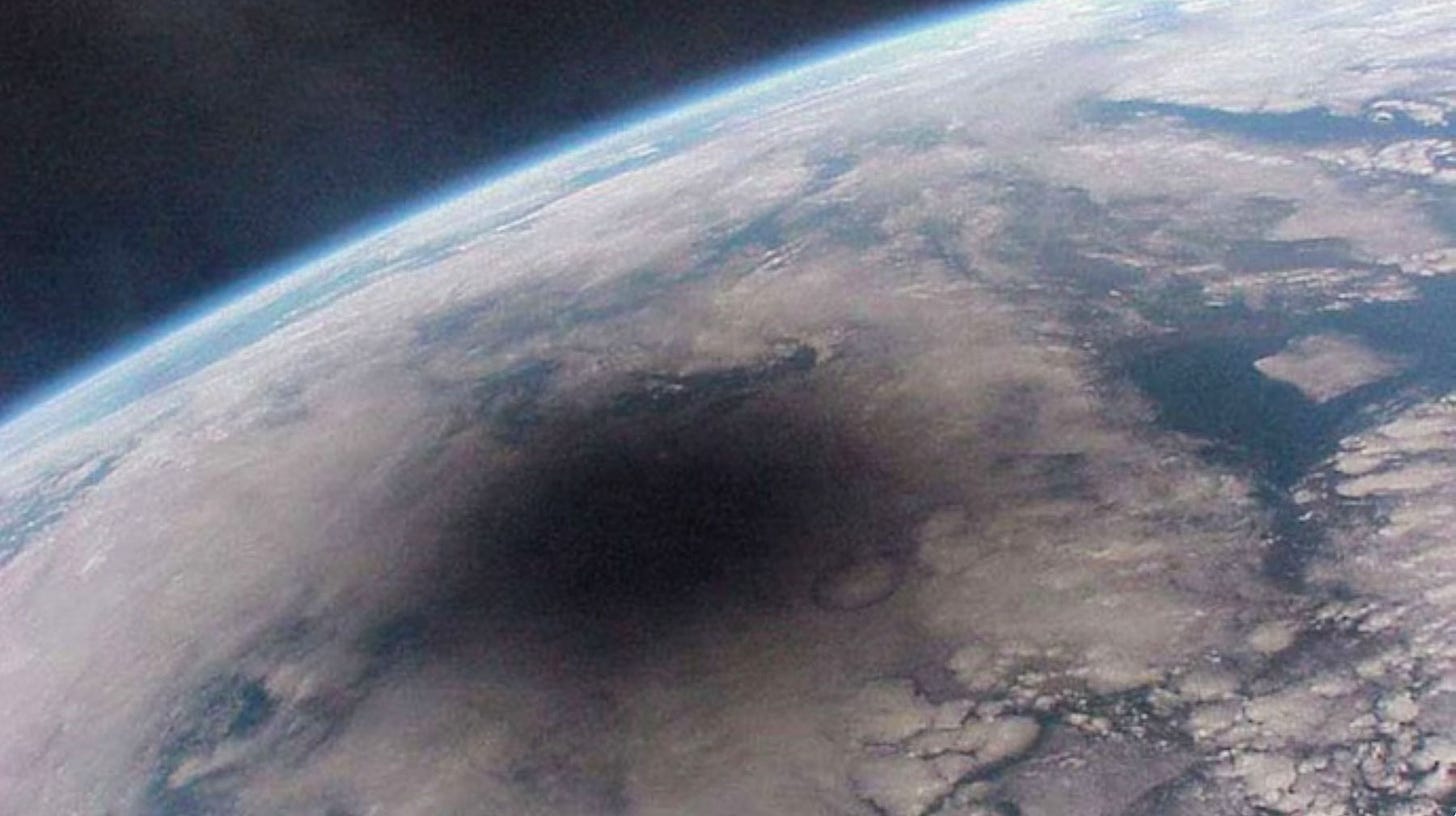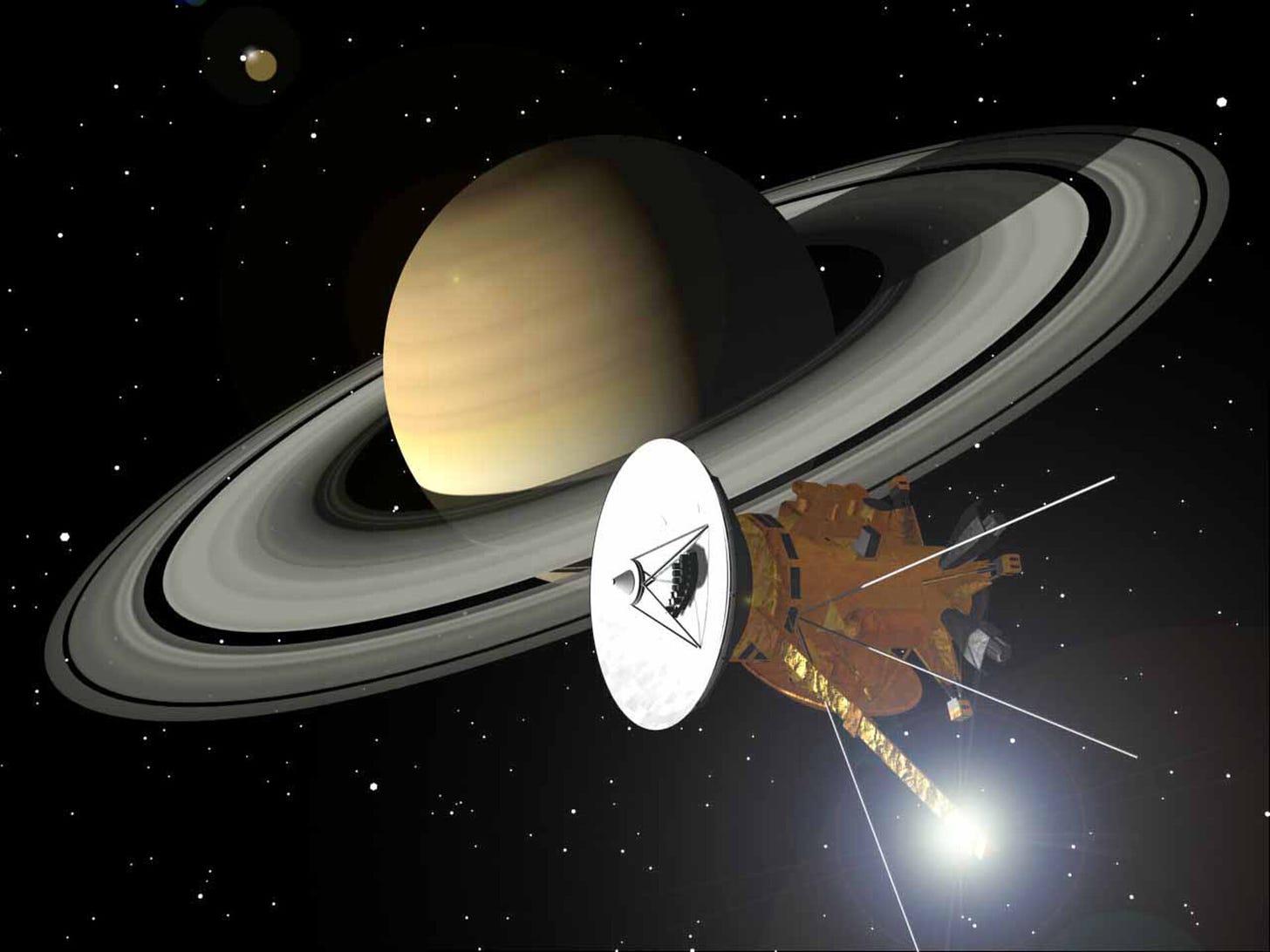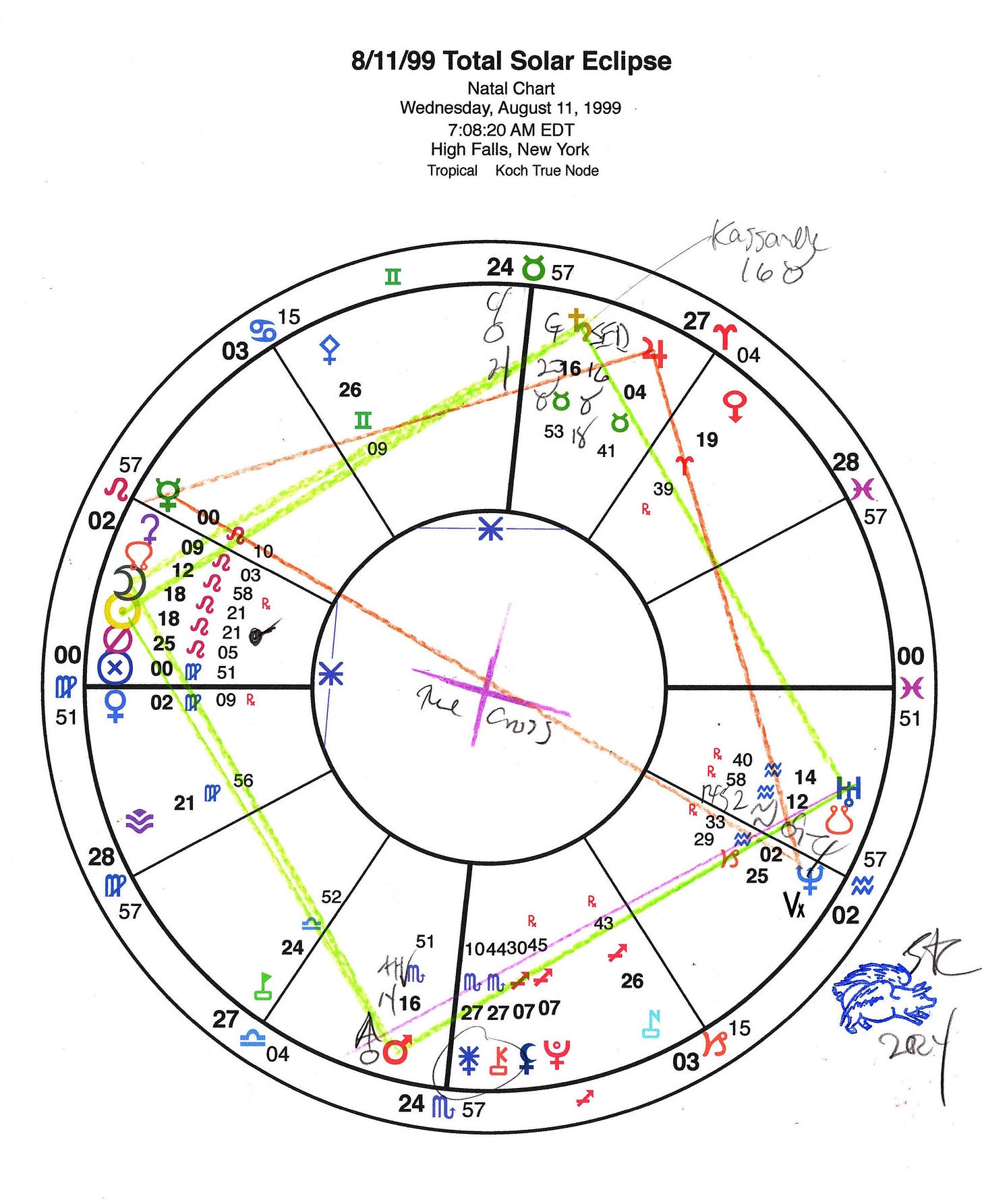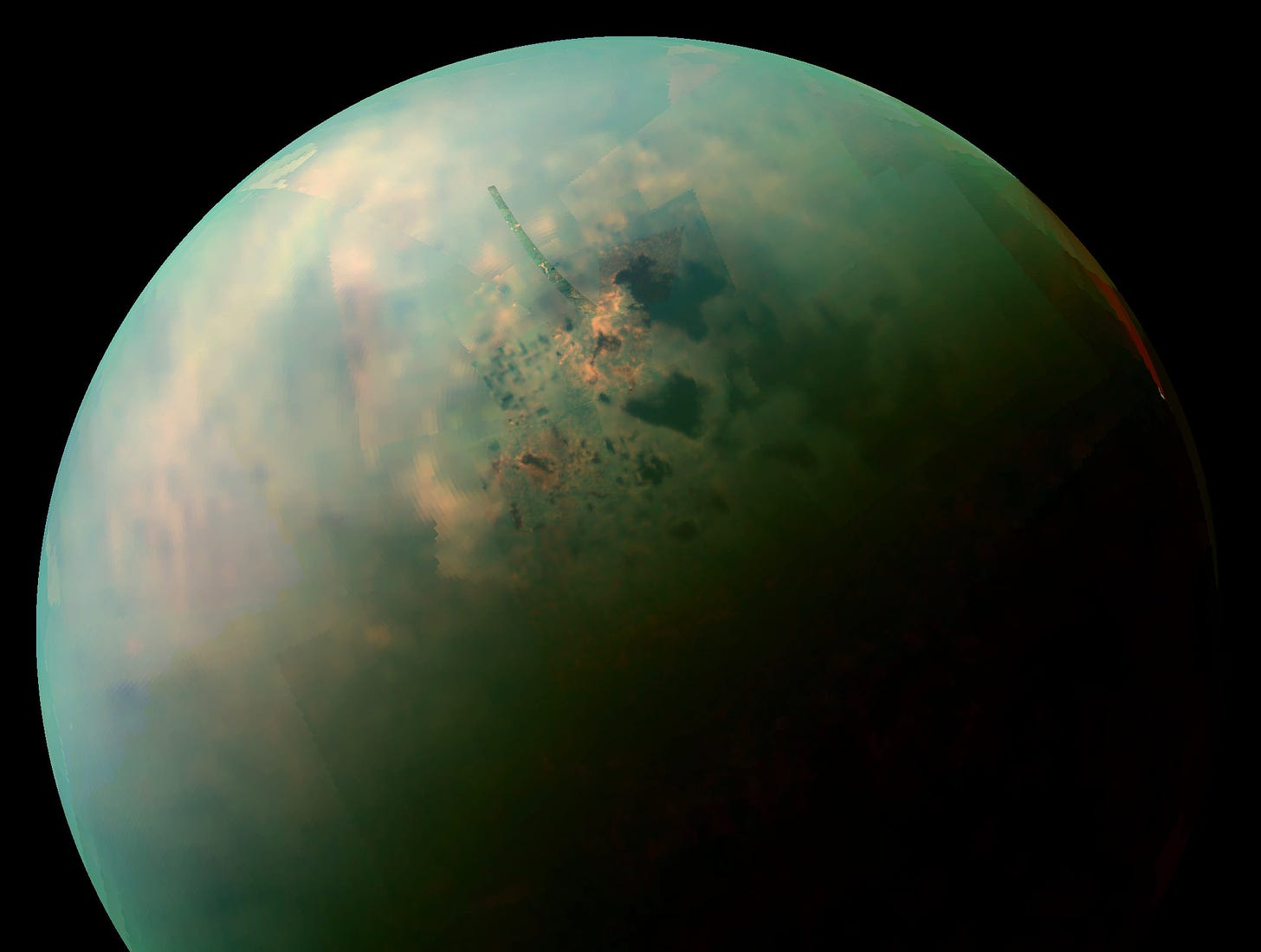
Dear Friend and Reader:
In the interview I re-published Saturday from the summer of 1998, I mentioned that I began studying Esoteric Astrology by Alice Bailey to help decode the chart of a then-forthcoming solar eclipse. Today is the 25th anniversary of that event, and I have a retrospective article and podcast for you.
A series of major astrological events marked the end of the 20th century and the beginning of the 21st. The first of these was the grand cross and total solar eclipse of Aug. 11, 1999, mentioned above. Another was the conjunction of Chiron and Pluto in Sagittarius on Dec. 30, 1999. Another was the Jupiter-Saturn conjunction in Taurus in 2000. And finally, the Saturn-Pluto opposition in the summer of 2001, associated with the 9/11 incident, started the 21st century with a bang.

Hello Cassini Space Probe
Eclipse or not, Aug. 11, 1999 was considered special because that was the day the Cassini Space Probe’s flight path took it from Venus back past the Earth with 72 pounds of plutonium-238 housed in a radiothermal isotope generator (RTG) battery used to power its various systems. The decaying plutonium makes heat, which is then converted to electricity.
While Cassini was ultimately headed for Saturn, it was launched from Earth in 1998, flown past Venus in a “slingshot” maneuver (properly called a “gravity assist boost”) to pick up speed without burning fuel, then flown back past the Earth for the same reason. (There was also a Jupiter slingshot en route to Saturn.)
This was possible because at the time, Jupiter and Saturn were in the same general direction (Taurus), aligned in their conjunction of 2000. So the whole mission was timed with the Jupiter-Saturn conjunction. Because Cassini could increase its velocity going past Jupiter, this saved even more travel time to Saturn.
I’m not sure how much, but it’s a long way from Jupiter to Saturn. Also, they got new photos of Jupiter during the flyby, so that was a plus — and they tested the camera systems.
The Risk of Accidental Re-Entry
Yet this Earth flyby was to be conducted at the risk of Cassini’s accidental re-entry into Earth’s atmosphere, which would have burned up and distributed the plutonium throughout the planet — not a good idea. Thankfully, the mission went well.
We can credit Prof. Karl Grossman at SUNY Westbury, a journalism professor, author and specialist in the nuclear space program, who raised public awareness of the dangers. Thanks to his efforts, NASA raised the flyby altitude to nearly double the originally-planned 400 miles — adjusting the flight to about 750 miles above the surface of the Earth.
So far as I can tell, one professor raising a fuss and informing the public got that result.
Listen to my 2022 interview with Karl Grossman on PWFM
What seemed really incredible at the time, and in retrospect, is that the flyby was planned for within hours of an ominous total solar eclipse, which was also described by a Nostradamus quatrain from many centuries earlier:
The year 1999 seven month,
From the sky will come a great King of terror:
To bring back to life the great King of Angolmois, (the Mongols),
Before after Mars to reign by good luck
(Century X, Quatrain 72)
This bit of poetry was written in the mid-1500s, long before the days in the seventh month had become the eighth month due to the correction made at the time the Gregorian calendar was adopted in place of the ancient Julian (as in Julius Ceasar) calendar in 1582. So Nostradamus was bang-on foreseeing an issue in August 1999.
I challenge anyone to explain this rationally.

An Ominous Chart
As if Nostradamus whispering from the 16th century was not enough, the chart was ominous, first, because it was an unusually potent eclipse, streaking across Europe. But the chart pattern is what concerned most astrologers: a grand square including the Moon, the Sun, the Nodes, Mars, Saturn and Uranus. That’s a lot of tension.
And the square occupied the fixed signs Taurus, Leo, Scorpio and Aquarius, the very ones described in the Book of Revelation, and depicted in The World tarot card. So as you can imagine, the paranoia about this eclipse was running wild.
For Sedna fans, the then-undiscovered very distant planet was in an exact conjunction with Saturn in Taurus — exact to the very degree. Also in that degree is — get this — Kassandra, which is about prophecy, and whether or not people believe it.
So the chart said we had reason to be concerned, particularly given how the flyby was to happen within hours of the eclipse. But, everything went well, and Cassini hurled past Earth at 42,000 miles per hour, then eventually past Jupiter, then finally to Saturn, where it was parked in a stable orbit on July 1, 2004. The journey from launch to arrival took about six years.
NASA Disposed of the Craft by Plunging it into Saturn
When the Cassini mission finally ended on Sept. 15, 2017, NASA plunged the craft and its load of plutonium-238 into Saturn to avoid having it strike one of Saturn’s planet-size natural satellites, some of which are thought to potentially harbor life.
It was deemed safer to burn up the craft and the plutonium directly within Saturn rather than a terrestrial world where evolution might be taking place.
Though this is a little speculative, I reckon they made the right decision. As an aside, when I lived in Paris, I visited one of the offices associated with the mission (on the outskirts of the city) — that of the Huygens Probe that they dropped to Saturn’s giant moon Titan.
The scientist I spent the day with seemed remarkably ignorant of basic geophysics, and I ended the long meeting by giving her a copy of Raphael’s Ephemeris as we said good night on a campus walkway. It turned out there was a very serious calculation error on the timing of the Huygens part of the mission, which thankfully they caught in time.
(The error involved a plan to drop the probe from Cassini to Titan while the probe’s ability to radio the data back to the main craft and then to mission control was eclipsed by Saturn. I mean this was an absolutely absurd error that the South Park kids would have caught if they were doing this as a science fair project.)
In late 1998, I wrote what I consider the first Planet Waves article — Thinking of You on Judgment Day. The joke came from the idea for a box of Judgment Day greeting cards, since The Rapture was all the rage at the time. I’ve included a new version of the chart below, and a short description of the chart in a special STARCAST.
With love,



















Share this post